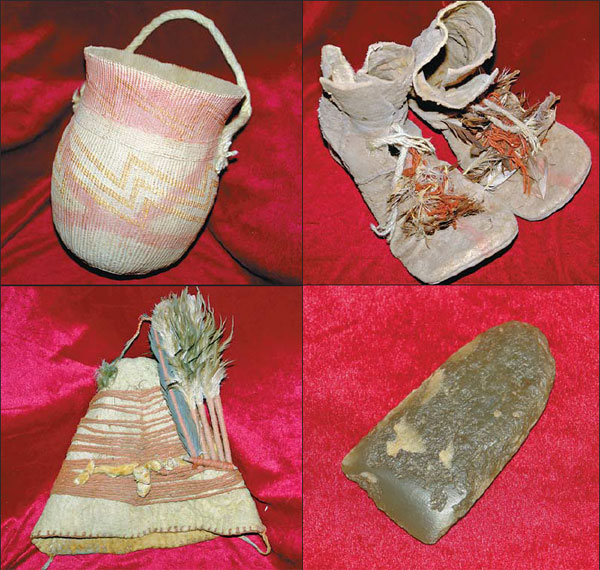 |
|
Clockwise from top: Items found at the Kungang tomb, including a basket made of straw, a pair of leather boots, a jade axe and a felt hat. Experts say the tomb could date back 4,600 years. Photos provided to China Daily
|
Alar sits at the northern edge of the world's second-largest desert, the Taklimakan, and on upper reaches of the Tarim River, which nourished a number of ancient civilizations in Xinjiang, and Liao instinctively felt that Kungang could related to one of them.
Deterioration
To ensure that the site was adequately protected, fences were hastily erected and a guard was hired, and now only one female mummy, wrapped in fragments of clothing, is on display in the exact location where she was found. "Her clothes were in one piece when she was first discovered and her face and eyebrows were clearly visible, but now the skeleton is showing and her condition deteriorates every day," said the guard. The skin has also flaked off two mummies kept at the museum at Tarim University, exposing their skeletons.
According to Liao, more mummies may still be buried in the sand dunes, but the institute doesn't have the funds or expertise required for effective excavation and preservation, so the experts have decided not to dig any further.
Ancient dried-up river courses are visible near the tomb and the poplar trees are still growing strong. Relics, including rudimentary boots, baskets made from grass and reeds, and wooden phalluses and statues, are culturally consistent with those found in the famous Xiaohe, or "Small river", tomb at Lop Nur, a dried-up lake in southern Xinjiang, but the Kungang mummies are much taller, according to Liao.
The well-preserved mummy of a young woman, dubbed "The Beauty of Xiaohe", was among the 30 mummies found at the lake site, the earliest of which dates from around 4,000 years ago.
Liao said a living area has been identified close to Kungang, but its archaeological importance is limited because the site has been severely damaged by the elements and grave robbers.
The size of the tomb and the huge number of relics discovered indicate the existence of a huge population with a long history, according to a research paper published in April 2013 by Victor Mair of the University of Pennsylvania in the US and Cheng Fangyi of Tsinghua University in Beijing.
The authors suggested that the relics Liao claims to have discovered at Kungang may actually derive from an ancient cemetery on Alar's southern border and argued that they had been handled unprofessionally and may have been inadvertantly lumped together with material from other areas.
The human museum
Xinjiang is known for its dry climate and sandy landforms, resulting in ancient corpses dehydrating quickly and mummifying, so the region is a museum of the human race, according to Tian Weijiang, a researcher at the Xinjiang Academy of Social Sciences.
"Archaeological evidence indicates that human beings from different races have lived in Xinjiang since prehistoric times because of the area's location on the border of Central Asia. In the Xiaohe tomb, we found the remains of ancient Europeans and Mongolians," he said.
We Recommend:
